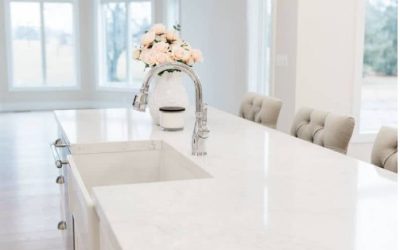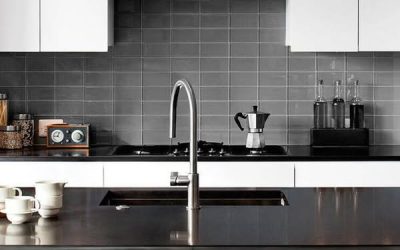In the world of large-scale residential and commercial projects, the right surface materials can make or break profitability, scheduling, and client satisfaction. Laminate countertops and surfaces remain a powerhouse choice for national builders when designed and executed with precision. At L.E. Smith, we’ve spent decades refining our approach to laminate fabrication and delivery, making us a trusted partner for builders who demand quality, speed, and consistency.
Below are the key design considerations and strategies for national builders who want to leverage laminate in large-volume projects, without compromising aesthetic appeal or performance.
1. Match Style Trends Without Overextending Costs
Builders face constant pressure to deliver stylish interiors at scale. Laminate gives you flexibility:
• High-definition & 180FX surfaces can mimic the look of stone, marble, or quartz to the untrained eye offering “designer finishes” without the price premium.
• L.E. Smith carries 150 stock colors across multiple edge profiles, ensuring that standard models can align with a variety of design palettes.
• For accent pieces, specialty laminates or custom colors are available but can be limited to high-visibility areas to minimize cost and lead-time pressure.
• By anchoring most units in stock palettes and reserving custom options for focal pieces, builders can manage inventory, reduce complexity, and deliver consistent looks across multiple sites.
2. Edge Profiles & Edge Construction
One of the most visible signs of quality in laminate is the edge treatment:
• Gone are the days of simply wrapping a flat laminate edge. Modern profiles replicate full-depth edges, bevels, waterfalls, and more. See our edge profile options here.
• L.E. Smith supports a wide variety of post-form edges, self-edge tops, and AWI-compliant self-edge tops to meet architectural specifications.
• For high-volume projects, standardizing on one or two edge profiles (e.g. squared-off or slight bevel) can dramatically simplify production and reduce waste.
• Edge detail is one area where small design decisions ripple through budget, production, and install complexity.
3. Modular Layouts & Unit Labeling
Large national builders often deliver hundreds or thousands of units across multiple projects. Design decisions should reflect this:
• Modular layouts (consistent countertop sizes, sink cutouts, etc.) reduce fabricator complexity and facilitate bulk ordering.
• Unit labeling becomes critical: L.E. Smith provides unit-labeled tops and surfaces for multi-family and phased buildings, helping streamline field installation and reduce errors.
• Coordinate with cabinetry teams to align heights, overhangs, and plumbing rough-ins so that laminate tops slot in without last-minute adjustments.
• At scale, consistency between design and field expectations is your buffer against time delays and install rework.
4. Lead Times, Reliability & Project Assurance
One of the biggest risks in multi-site builds is supply chain disruption and missed deliveries. Builders should evaluate:
• Turn-time guarantees: L.E. Smith offers one-week turn times for stock colors and competitive timelines (2–3 weeks) for custom or non-stock orders.
• On-time delivery track record: For over a decade, L.E. Smith has maintained a 95% on-time delivery record.
• Project phasing & scheduling support: L.E. Smith provides project management, measurement, and installation services to support phased rollouts.
• When your interior finishes line up with trades, HVAC, plumbing, and inspections, reliability in surface delivery is nonnegotiable.
5. Durability, Maintenance & Warranty Expectations
Builders must design for occupant use and resale or turnover. Laminate offers compelling performance:
• Scratch, stain, and wear resistance are built-in, and surfaces remain non-porous, resisting moisture and staining without sealing.
• L.E. Smith’s relationships with top brands like Formica® and Wilsonart® ensure quality control throughout the supply chain.
• Warranty terms should align with project scale. Every unit installed through L.E. Smith is backed by industry-standard protections, ensuring peace of mind for builders and end users alike.
6. Coordination & Communication: The Key Differentiator
Even the best design is only as good as communication:
• Provide detailed spec sheets, layout diagrams, and measurement expectations to your fabricator upfront.
• Ensure design freeze deadlines are enforced — changes late in the process drive cost, rework, and delays.
• Use your fabricator’s feedback: L.E. Smith’s decades of experience give us insight into what works in real-world installations.
• A true partnership means your design team and fabricator move together, not in isolation.
7. Scaling Across Regions & Multiple Projects
For national builders operating in multiple markets:
• Use a single fabricator or trusted fabricator network to standardize quality, reduce regional variance, and centralize coordination.
• Build buffer into lead times for regional shipping, customs (if applicable), and local installer scheduling.
• Integrate your product lifecycle: if finishes or palettes shift, deploy change windows during low-volume seasons to minimize disruption.
• L.E. Smith’s capacity of fabricating ~10,000 laminate tops per month positions us to support large-scale rollouts.
With years of expertise, project support, and a track record of reliability, L.E. Smith is a strategic partner. If you’re planning upcoming residential or commercial builds and want to optimize your laminate design strategy, contact us to explore how our capacity, standards, and support can give your projects a competitive edge.



